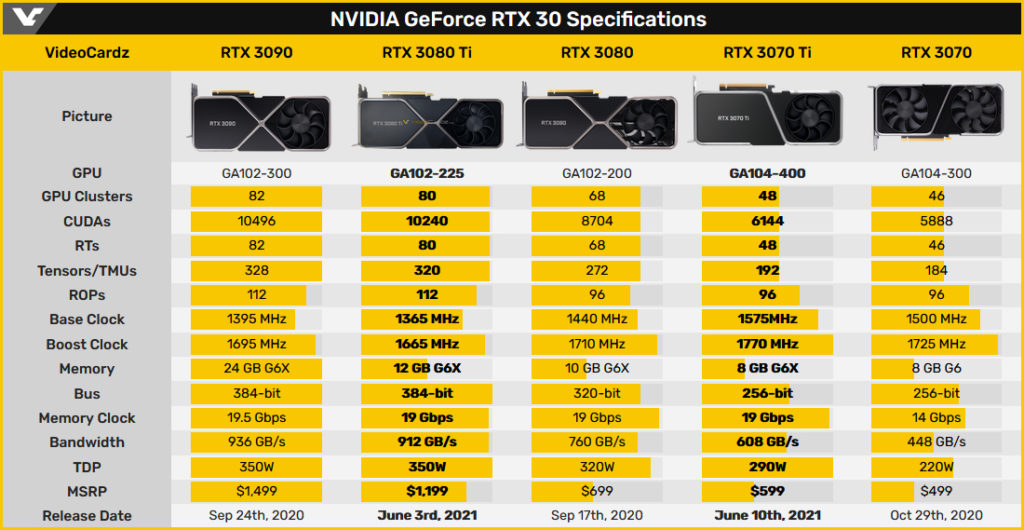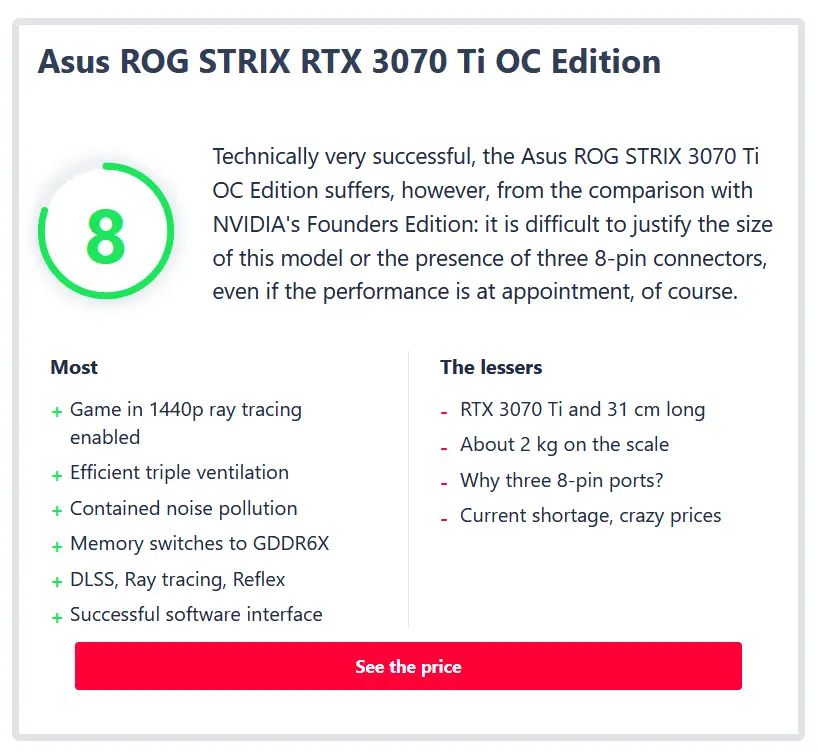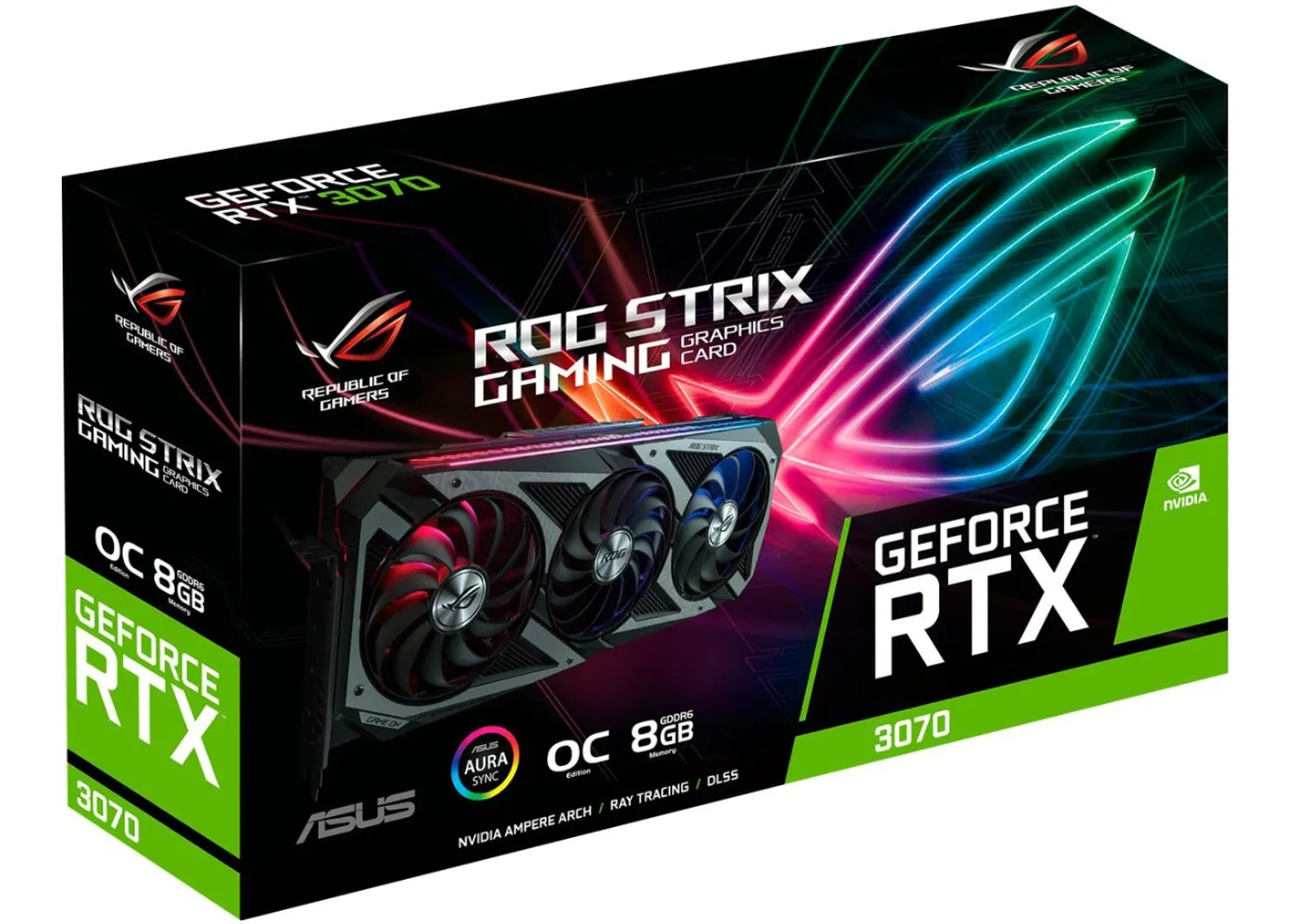For each new best graphics card , we proceeded in the same way: a few days after having offered you the AMD or NVIDIA reference design test, we put forward a custom model, the work of one of the brand’s partners. This time, it’s Asus that sticks to it with the ROG STRIX 3070 Ti OC Edition, an extended name for a card that you will, unfortunately, still have a hard time finding in stores. Sad period.
Our Review
The Republic of Gamers range – ROG for close friends – is well known to gamers as it is a flagship for the entire Asus catalog. In the field of graphics cards, the range is identified by the STRIX models of which we now have a proud representative in our hands.
Note however that Asus has other models of RTX 3070 Ti Graphics Card … even if their availability is not greater than that of the STRIX. The “first prize” goes to the DUAL range which is distinguished by its double ventilation and the “intermediary” goes to TUF Gaming cards which exist in two versions: 8G and 8G OC.
Asus ROG STRIX RTX 3070 Ti OC Edition Specifications
Note that as with the TUF Gaming range, there are two versions of the ROG STRIX RTX 3070 Ti. Alongside this OC Edition tested here, Asus also has in its catalog a ROG STRIX RTX 3070 Ti “very short”. As we can imagine, the difference between the two is subtle: it is mainly due to the boost frequency certified by Asus, 1800 MHz in one case and 1875 MHz in the other.
The Asus ROG STRIX RTX 3070 Ti OC Edition is:
- GPU: GA104-400
- NVIDIA Architecture: Ampere
- CUDA cores: 6,144
- Boost frequency: 1.875 GHz
- Memory configuration: 8 GB GDDR6X
- Memory interface: 256-bit
- Hearts of Ray Tracing: 48 hearts 2 e generation
- Hearts Tensor: 192 hearts 3 th generation
- PCI Express Gen 4: Yes
- NVIDIA NVLink ™ (SLI-Ready): No
- HDMI 2.1: Yes
- DisplayPort 1.4a: Yes
- Standard display connectors: 2x HDMI 2.1, 3x DisplayPort 1.4a
- HDCP: 2.3
- Length: 318.5 mm
- Width: 140.1 mm
- Height: 2.9 PCIe slots
- Weight: 1,820 grams
- Maximum GPU temperature: 93 ° C
- Graphics consumption: 310 Watts
- Recommended system power: 750 Watts
- Power connectors : 3×8 pin PCIe
- Guarantee: 2 years
- Price and availability: available, no MSRP communicated by Asus
Of course, the spec sheet for the Asus ROG STRIX 3070 Ti OC Edition displays basic specs that are identical to those of the Founders Edition that we were testing a few days ago . The GPU is the same and we therefore end up with a number of identical CUDA, RT and Tensor cores. OC Edition requires, however, ASUS wanted to boost the frequencies of its card a little even if the difference is ultimately only about 5.6%. Another change, and we will come back to it right away, the design of the card is obviously different: much more cumbersome.

32 cm: the longer, the better?
While the RTX 3070 Ti Founders Edition signed NVIDIA had the good taste of being rather compact, we are moving away from this perspective with the ROG STRIX model which may have all the trouble in the world to fit into slightly cramped cases. And for good reason, this version is 31 centimeters long … almost 5 cm more than the card offered by NVIDIA.
In width, the observation is more or less the same with a card that is slightly longer than 14 cm – against 11.2 cm on the Founders Edition – and will pose serious problems for holders of narrow cases: you could simply not be able to close the case. side wall.
Also, don’t forget that this 31.85cm is more than the width of an ATX-formatted motherboard and that the Asus ROG STRIX 3070 Ti OC Edition is a 2.9- slot graphics card : in other words, it is thick enough to occupy more than two PCI Express slots. In this kind of case, we do not find the comma and it takes three monopolized slots . Problem: On some motherboards, this means covering the M.2 slot dedicated to the Wi-Fi controller or, more annoyingly, the second NVMe SSD. ” More embarrassing “? Yes, because it will not necessarily be possible to place any SSD in your config: those with a large heatsink are particularly excluded.

Last but not least: the ASUS card is heavy. At over 1.8 kilograms, it increases the weight of the RTX 3070 Ti Founders Edition by almost 47%! You will tell me, considering the overall weight of a PC, it is not that dramatic. Except that the PCI Express ports were not designed for such a load and it is moreover more rare to see manufacturers of motherboards offering “reinforced” slots.
With its RTX 3080 Ti Suprim X model – at more than 2,000 euros – MSI, for example, has taken care to deliver a support accessory: on its RTX 3070 Ti Suprim X, the company does not make the same choice and neither does Asus on our test model. Pity.
Three 8-pin power plugs… useful?
You are used to it now, the question of powering the GeForces is a little more “delicate” than that of the Radeons. NVIDIA has effectively opted for a 12-pin single connector system to simplify connections, but no partner manufacturer has followed suit. All of them use 8-pin connectors and in the case of the RTX 3080 Ti Suprim X, we were not surprised to see MSI integrate three of them: you have to feed this little beast. The RTX 3070 Ti version of the said Suprim X is logically less greedy and MSI was satisfied with two 8-pin sockets… not Asus. The ROG STRIX 3070 Ti thus retains three connectors.
To be completely honest, we do not understand this choice of Asus, which is struggling to justify itself. The manufacturer also mentions a maximum consumption of 310 Watts: we therefore do not clearly see the interest of these three connectors … which we can only find here! Neither Gigabyte, MSI, nor Zotac are following this path.
For the rest, not much to report: Asus logically recommends a power supply capable of delivering 750 Watts. The Taiwanese still incorporates his ingenious little red LED system to indicate that the 8-pin connectors are not connected: this avoids unpleasant surprises when turning on the machine.
8 GB of GDDR6X RAM
To justify the OC Edition terminology of its ROG STRIX 3070 Ti, ASUS has logically boosted the operating frequencies of the graphics card a little. In gaming mode , it is thus a question of 1845 MHz against 1770 MHz for the Founders Edition. An OC mode is present in order to reach 1875 MHz.
However, nothing to report on the side of the video memory on board the card. Like all other manufacturers, ASUS remains true to NVIDIA specifications. We will therefore be satisfied with a 256-bit bus memory clocked at a frequency of 9502 MHz, exactly as on the Founders Edition model.
If it is no longer a question of distinguishing itself from the reference model signed NVIDIA by the quantity or the type of on-board memory, these data remain interesting. Indeed, on the one hand, Asus remains “wise” by offering the same quantity (8 GB) as on the RTX 3070 and, on the other hand, its model is evolving towards more power thanks to the use of GDDR6X. The stated objective is obviously to boost the bandwidth a little without the need to boost the frequencies: the GDDR6X effectively allows from 19 to 21 Gbps per pin, or, in the case of the RTX 3070 Ti, a total bandwidth of 608 Gb / s when the RTX 3070 had to be satisfied with 448 Gb / s.
Remember that the Radeon RX 6800s from the long- standing competitor, AMD, have a much greater amount of video memory – 16 GB – but in GDDR6. The interface being identical – 256-bit – the use of GDDR6X is once again an opportunity to stand out: the Radeon RX 6800 effectively has a bandwidth of “only” 512 GB / s. To see if this is felt when launching our fun tests.
Triple ventilation, dual software
Before launching into the benchs , it’s good to look at what distinguishes custom models from NVIDIA reference boards: the PCB and the ventilation system.
For PCB, we have already noted the essential differences. It should be noted, however, that this is significantly longer than that of NVIDIA and that a dual BIOS is involved to preserve silence ( Quiet mode ) or accentuate performance ( Power mode ). We opted for this power setting during our tests. Side ventilation, there is hardly any surprise in reality: Asus effectively renews the triple system of its ROG STRIX.
The idea is to offer three fans 92 mm in diameter to cool the map. Unlike MSI which connects the blades of its fans two by two, Asus circles all the blades of the same fan. In addition, the Taiwanese manufacturer reverses the direction of rotation of the central fan. The objective is to better direct the flow towards the critical parts of the card: the fans at the ends thus evacuate the hot air towards the back (for the one on the left) and the top of the case (for the one on the right). The result is up to Asus’ ambitions since the card is – under the same conditions – 5 to 6 degrees cooler than the Founders Edition, while being more discreet.
Not content with offering a very efficient cooling solution, Asus has its small specificity. Indeed, as on other ROG STRIX, it has two sockets for fans: the idea is to connect fans of the case to the card so that the latter operate according to the heat and the needs of the card. It is difficult in these conditions to overheat the GPU. Well seen.
Finally, Asus adds its software layer to the NVIDA Control Panel / GeForce Experience duo. As with all ROG devices, we first have Armory Crate. A little loaded, it monitors the vital signs on the card and adds options to manage the lighting and sync it with that of other Asus devices.
More interestingly, GPU Tweak is evolving towards version 3 ( in beta to download here ). It is card optimization, monitoring and overclocking software that is as comprehensive as it is readable and easy to access. We are convinced by this software which delivers what it promises and offers, in addition, a well thought – out overlay system .
Test protocol
Logically, this test of the ROG STRIX RTX 3070 Ti OC Edition is based on a platform strictly identical to that used for the RTX 3070 Ti Founders Edition, in order to simplify the comparison. Here is the exact detail:
- Processor: Intel Core i9-11900K
- Motherboard: Asus Z590-E Gaming WiFi (Chipset Intel Z590)
- Memory: Corsair Dominator Platinum RGB 32 GB DDR4 4000 CL19
- “System” SSD: Western Digital WD_Black SN850 1 TB (Type 2280)
- “Storage” SSD: Corsair MP400 4 TB (Type 2280)
- Power supply: beQuiet Straight Power 11, 1000 Watts Platinum
- Cooling: Corsair iCUE H150i RGB Pro XT 360mm
- Monitor: iiyama G-Master GB2888UHSU-B1, 4K 60Hz
We stress this systematically, but remember that if we try to keep identical software configurations between our different graphics card tests, we sometimes find ourselves facing constraints: in the case of the ROG STRIX RTX 3070 Ti OC Edition, we should specify that we did the tests on the GeForce 466.61 drivers while the 466.77 has just been released. The impact is undoubtedly minor, but it is still worth noting.
“Synthetic” measuring tools
On 3DMark’s TimeSpy Extreme test, the ROG STRIX RTX 3070 Ti OC Edition only saves 2.8% compared to the Founders Edition. It’s better, of course, and it puts the RTX 3070 FE even a little bit ahead. On the other hand, it is still insufficient to compete with the RTX 3080 FE… and even the Radeon RX 6800.
While Unigine Superposition tends to close ranks, it sings a bit different to us here and the Asus ROG STRIX card is now 3.35% faster than the RTX 3070 Ti FE, thus further ahead of the Radeon. RX 6800. On the other hand, the RTX 3080 FE remains largely out of reach.
Note that if the results in 2 160p are superior to those in
1440p and 1 080p, it is the consequence of an adjustment at the level of the shaders . So there is no error on our graph.
For our last “synthetic” test, we usually turn to ray tracing via the Port Royal scene of 3DMark. Funny enough, the gap between our ROG STRIX RTX 3070 Ti OC Edition and the RTX 3070 Ti FE is halfway between the previous two tests. We thus gain 3.1% in performance by opting for the Asus card, which comes close to the Radeon RX 6800 XT (-0.5%), as AMD cards are still struggling with ray tracing .
Performance observed in games
First video game test and first remark: the library used on DOOM Eternal is not the classic DirectX 12, but the very interesting Vulkan, which we regret is not used more by developers. In short, the fact remains that on this FPS – perfectly playable in 4K on our graphics card – the ROG STRIX RTX 3070 Ti OC Edition increases the animation by 3.3% compared to the Founders Edition, proportions very similar to which we had already noticed, but which leaves the Radeon RX 6800 still far ahead (-16.6%).
For The Division 2 , we suggest instead to keep the game at 1440p: the fluidity is still a bit tight in 4K (55 fps). In WQHD, on the other hand, no problem and our Asus card shows performance up “only” 2.7% compared to the RTX 3070 Ti FE. Sufficient, however, to beat a Radeon RX 6800 (+ 10.8%) which had already fallen behind.
Things are much tighter on the second Vulkan game in our selection, Red Dead Redemption 2 . Here again, we favor the 1440p game and the ROG STRIX RTX 3070 Ti OC Edition is on par with the RTX 3070 Ti FE (+ 0.4%) and the Radeon RX 6800 (- 0.1%).
Control is one of the few games where we enable ray tracing and DLSS. Logically, AMD cards are less celebratory and our Asus model is even ahead of the Radeon RX 6900. Compared to the RTX 3070 Ti FE, it shows performance up 4.6% (1080p), by 4. 1% (1440p) and 3.7% (2160p).
On Gears 5’s Unreal Engine 4 , the Radeon RXs are regaining strength and our ROG STRIX RTX 3070 Ti OC Edition is once again ahead of the Radeon RX 6800 (-4.6%). On the other hand, it is placed ahead of the Founders Edition, and this quite logically, although the differences are particularly small: + 1.9% in FHD, + 2% in WQHD and + 1.6% in UHD.
A little more flattering differences for the card signed Asus should be noted as soon as we go to Call of Duty Modern Warfare for which we have chosen to activate ray tracing . In 1080p, it is even on par with the Radeon RX 6800 while in 1440p, it is only a hair ahead (-0.72%). Compared to the Founders Edition, the differences are in the same orders of magnitude as observed previously: + 3.4% (1,080p), + 3% (1,440p) and + 2.7% (2,160p).
Efficient, the Decima engine used on Death Stranding allows you to enjoy the 2 160p very comfortably on many maps. Here, the ROG STRIX RTX 3070 Ti OC Edition is a step ahead of the Radeon RX 6800 (+ 1.8%), but stands out more clearly from the Founders Edition (+ 3.7%).
To put an end to the video game tests, we launched Cyberpunk 2077 on which we had activated the options – in ultra – ray tracing and DLSS. Note that as long as AMD has not implemented its FidelityFX Super Resolution, such options will continue to clearly favor NVIDIA cards.
The fact remains that even the 1440p is not very pleasant: at an average of 60 fps, fluidity is not guaranteed. Even in 1080p, it’s not perfect (74 fps) and the progress made between the Founders Edition and our Asus ROG STRIX is still insufficient (+ 2.8%).
Consumption and efficiency
It is a constant, the custom models a little “sophisticated” consume more than the Founders Edition of NVIDIA. Logically, this is reflected in the test of the ROG STRIX RTX 3070 Ti OC Edition. To verify this, we measured the consumption of the PC with a power meter, at rest and then under full load. We then compared these results with those reported by the latest beta of MSI Afterburner.
The Founders Edition could swallow almost 300 Watts, and here we are slightly above that threshold. On the 3DMark TimeSpy Extreme, it should be noted that consumption seems to increase in proportion to performance.
An impression more or less confirmed by the “energy balance” of the two cards: they actually fit in a pocket square, but are noticeably less efficient than the RTX 3070 FE. For comparison, here are the performance / Watts ratios obtained on some “current” cards (the higher the better):
- Radeon RX 6700 XT: 28.45
- AMD Radeon RX 5700 XT: 16.98
- Radeon RX 6800 XT: 30.18
- GeForce RTX 3070 FE: 29.48
- GeForce RTX 3070 Ti FE: 24.86
- Asus ROG STRIX 3070 Ti OC Edition: 24.84
- GeForce RTX 3080 FE: 27.52
- GeForce RTX 3080 Ti FE: 27.40
We now come to the “annoying” point. Of course, Asus is not responsible for the situation and it is also so complicated that the manufacturer no longer takes the trouble to communicate an “official price”, the famous MSRP once widely put forward. American colleagues have estimated it at 950 euros for this card.
Keep in mind that this is only an estimate, which however makes the card much less “profitable” than a Founders Edition (619 euros). We actually get a performance / price ratio of 7.93 compared to the FE card’s 11.84. Worse, taking the “real” selling price (1,299.95 euros at LDLC), this ratio collapsed to 5.79. It is really time for things to get back to about “normal”.
Asus ROG STRIX RTX 3070 Ti OC Edition: Clubic’s user review
Without it being possible to speak of revolution, the ROG STRIX increases still a small notch the performances obtained by the RTX 3070 Ti in Founders Edition version. The difference with the “standard” RTX 3070 is even clearer.
Unfortunately, to get these few extra frames per second, you have to lengthen a lot of tickets. In fact, the ROG STRIX is overwhelmed by the Founders Edition based on RTX 3080 Graphics Card: less big, more powerful and, above all, less expensive, the latter is more interesting on all levels … if not on the side of noise pollution .
Let’s get on well, this does not call into question the qualities of this card. Simply, with a “normal” price, you have to weigh the pros and cons of each product according to the (too rare) purchasing opportunities of the moment.

Also See: – Best Monitors For RTX 3070 Ti – Best HDMI 2.1 Monitors

